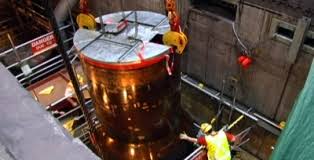
Firm kicks-off effort to prepare a submission to the NRC for safety review
Hyperion-Nuclear Power Generation, which is designing a small, 25 MWe, nuclear reactor, revealed design details on November 18, about the company's product at the Winter meeting of the American Nuclear Society taking place in Washington, DC.

This is the first release of reactor design information by the company. It marks the kick-off of the firm’s pre-application process with the NRC for safety analysis review that leads to a reactor design certification decision by the agency.
No matter where, globally, Hyperion plans to build their reactor, the NRC certification is a critical success factor because the agency’s regulatory review is considered to be the “gold standard” by other countries.
According to John Grizz Deal, Hyperion CEO, the firm plans to submit its design to the NRC in late 2010 or early 2011. Hyperion technical staff said the NRC learning curve is a challenge since it is not a light water reactor.
“We hope that it will not be too hard for them to understand our design. We choose technologies for fuel and fuel cladding that are well understood from a safety perspective.”
Design details
The sealed core, which is good for up to 10 years, does not require refueling at the customer site. Instead, the entire mechanism is replaced by a new one. The first use of the reactor at a customer site will be to produce electricity. The planned output of the reactor will be 25 MWe. Other applications include process heat and power for remote military applications. The company claims to have numerous customers lined up to buy the units.
Features Include
* Each unit will generate approximately 70MWt and 25MWe – enough to power 20,000 average American homes.
* The temperature of the secondary loop is 450-500 F. The secondary loop is a liquid metal circuit to produce steam so that there is no contact between the primary reactor and water in any form.
* Overnight costs are estimated by the firm to be $2,000 - $3,000 per KW capacity. The bottom line market goal is to generate electricity for approximately US$0.10 per kWh anywhere in the world.
Hyperion Reactor Information

The reactor is intended to meet requirements for dedicated power by hospitals, factories, foundries, government centers, water treatment, or irrigation and desalinization. Resource intensive uses at remote sites include mining and oil production & refining. Military facilities that cannot compromise tactical readiness relative to having enough electricity may find the small footprint of the reactor and ease of transport to be of interest.
Safe shutdown
The reactor has two shutdown systems which provides redundancy. In event of a problem, there is a space in the center of the core into which the operator can rapidly dumped marble size boron pellets which will lead to rapid shutdown of the reactor.
Hyperion Plan Review of Active Core

Once reactor comes to end of fuel cycle, in about 5-10 years, it takes two years to cool down via air circulation. Then the entire reactor can be removed for disposition. Ideally, a customer will have two setups for these reactors so that one slot is empty at startup of the first one. When it’s done, you put the new one in the empty space, and let the old one cool off in place for two years. Then the customer can arrange for Hyperion to remove it. It gives new meaning to the term “plug and play.”
Future fuel fabrication plans
Fuel will be enriched to between 15-19.6% because this small reactor needs more highly enriched fuel to get power levels to point of economic value. Fuel is a uranium nitride alloy. No fuel has been fabricated or tested so far. A system engineer at Hyperion said in an interview INL’s ATR is an option for testing fuel. Other international sites (unnamed) are also interested if ATR is not available. The firm’s goal is to verify that fuel meets requirements for higher burn-up rates.
Hyperion said in October it plans to build a factory to make the reactors in the UK. CEO Deal is making a simultaneous announcement there about design details this week. Nuclear Engineering International Magazine published a technical update 11/19/09.
 Australian Uranium News - Research
Australian Uranium News - Research








